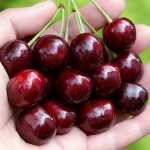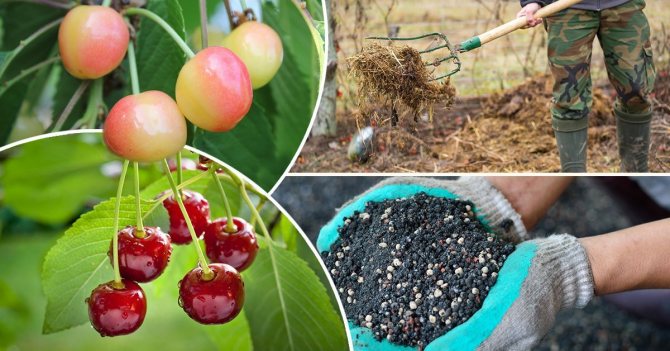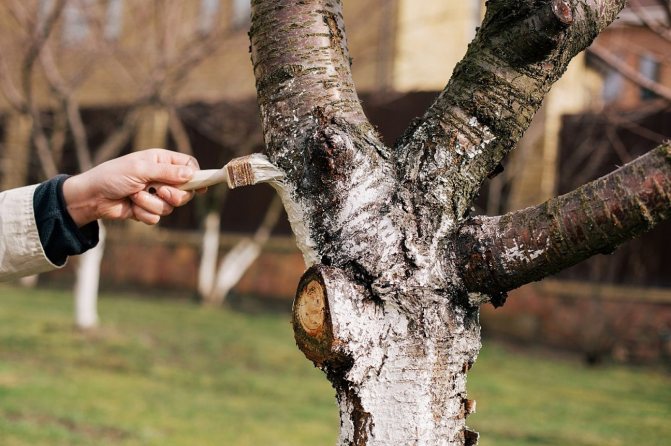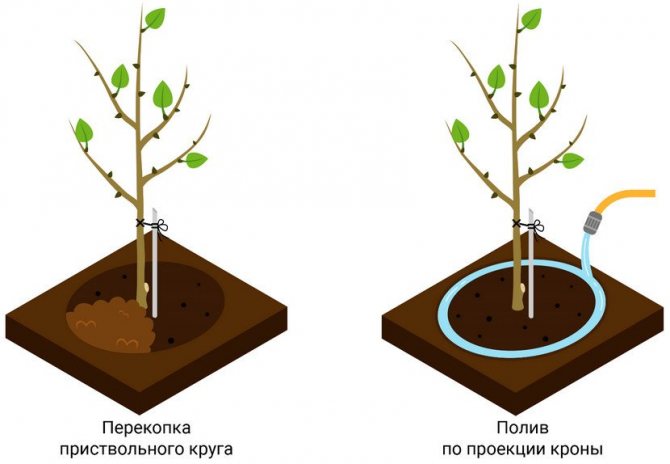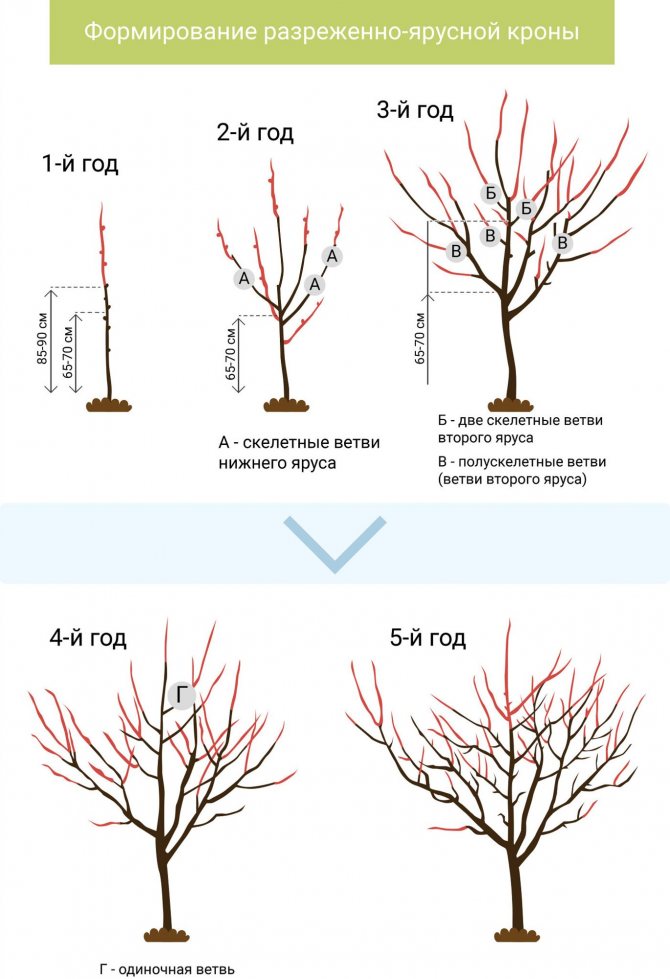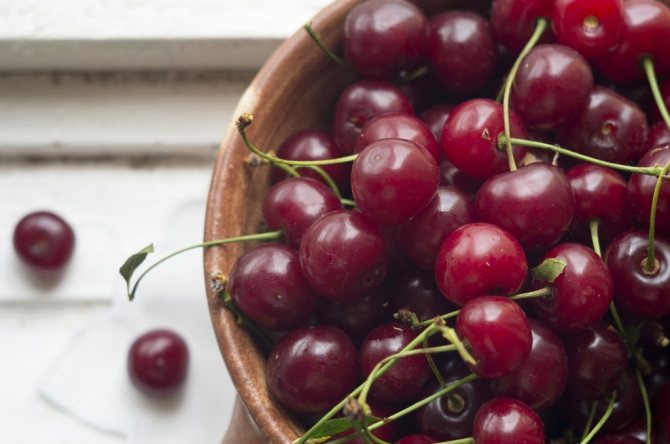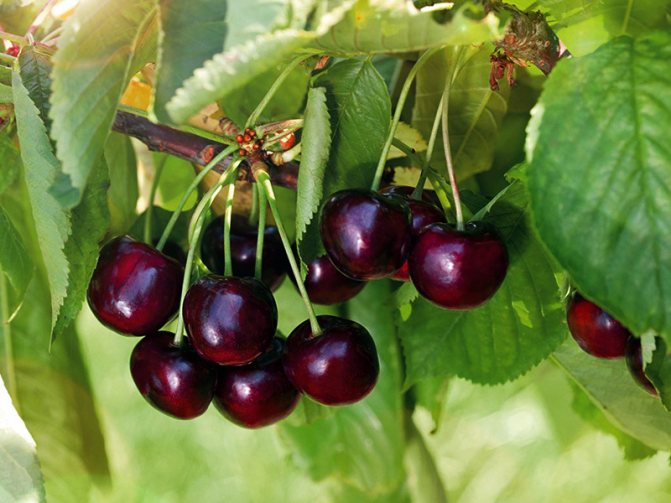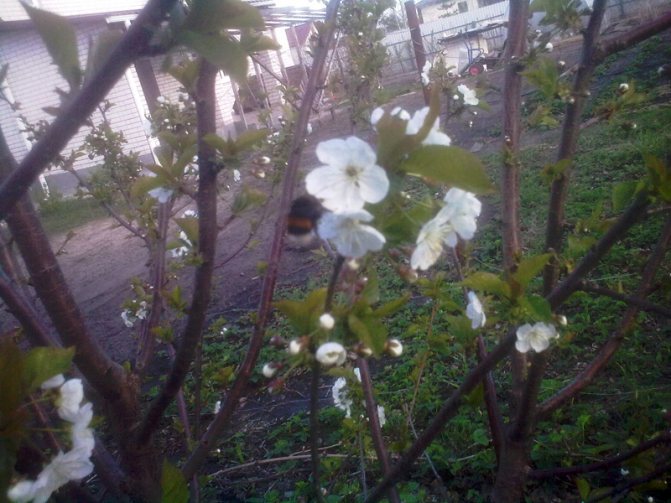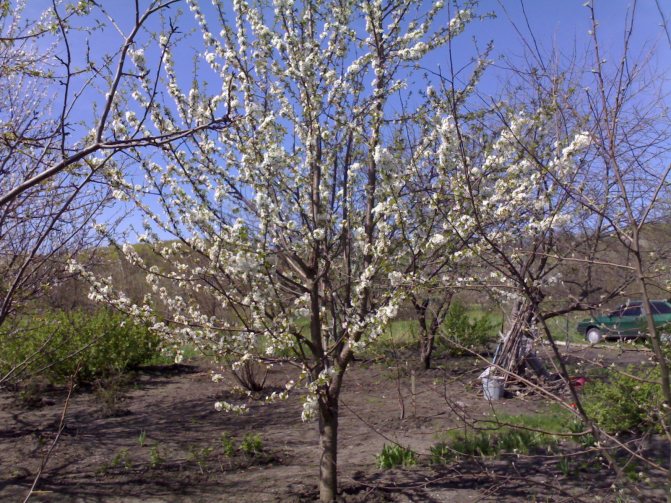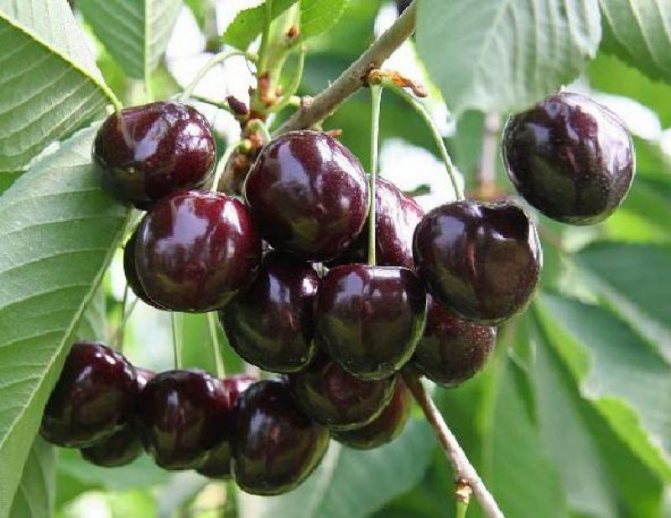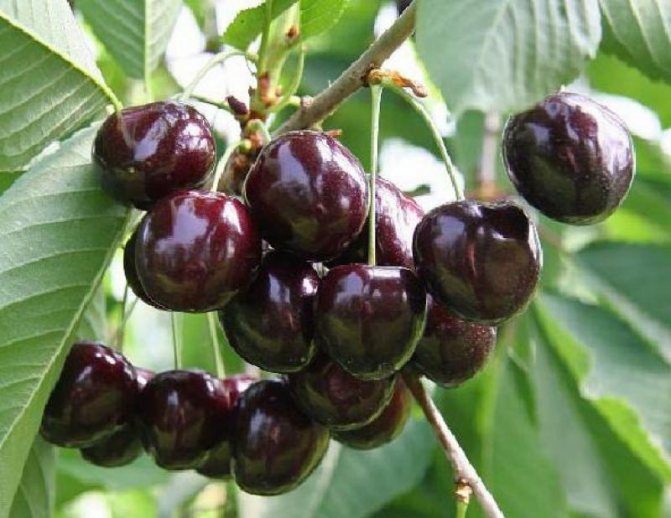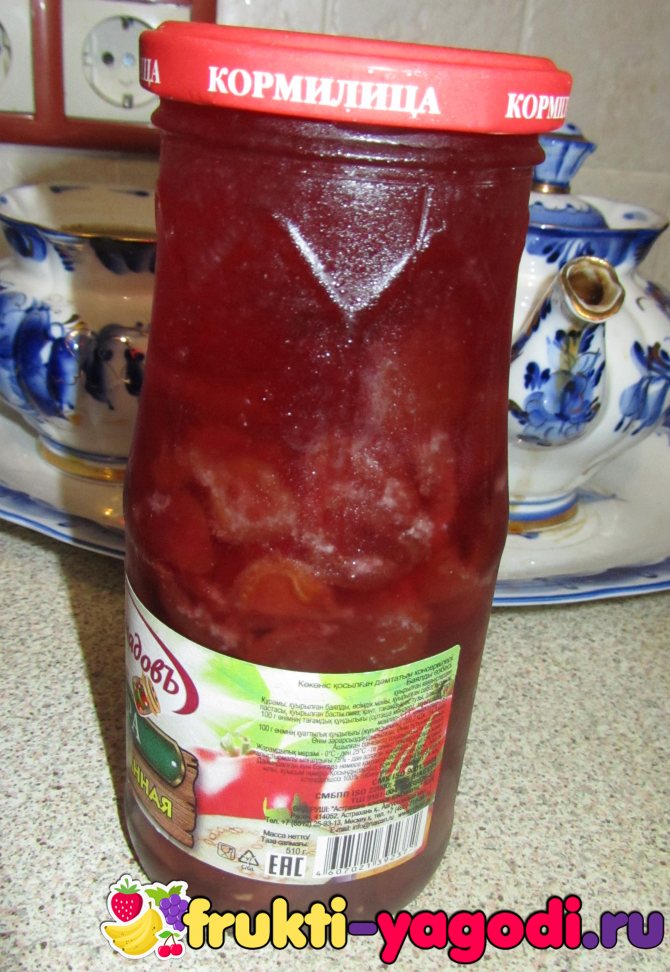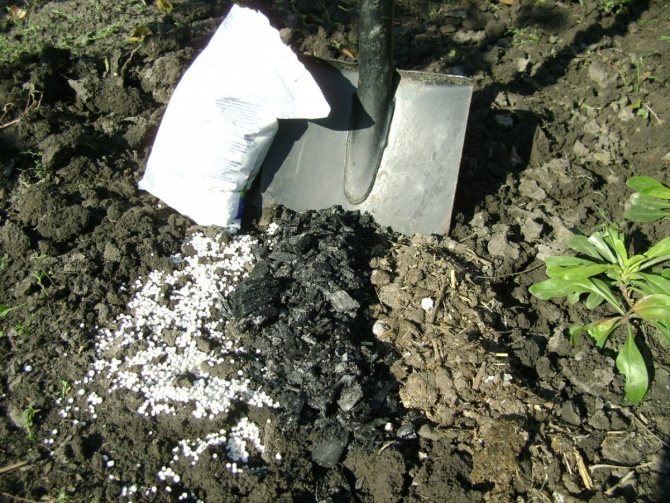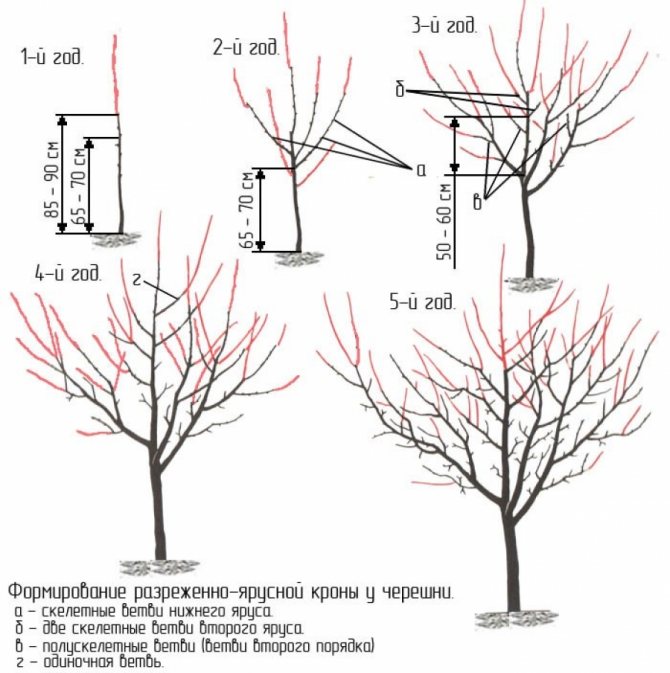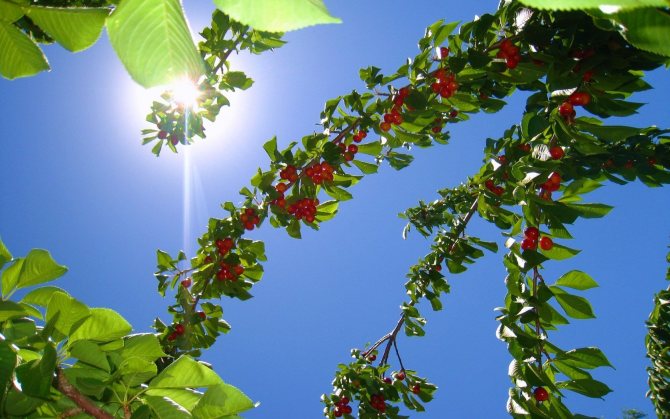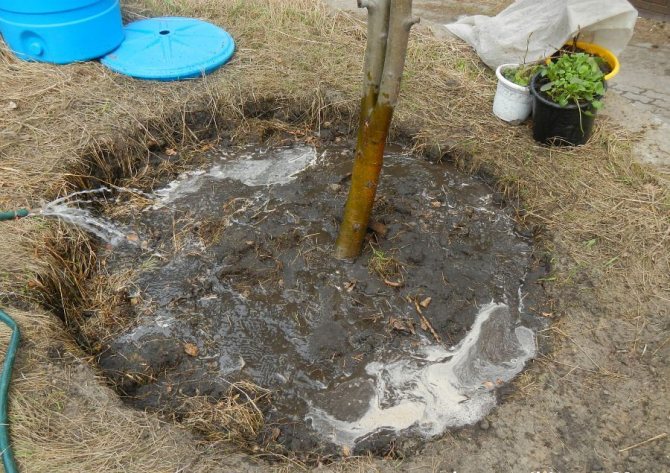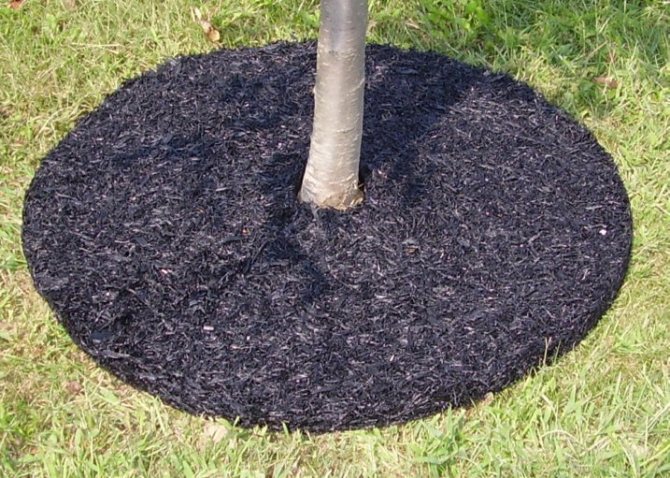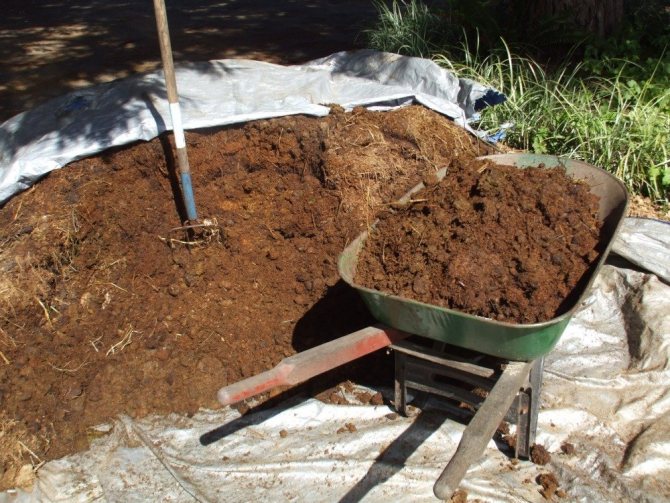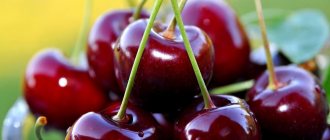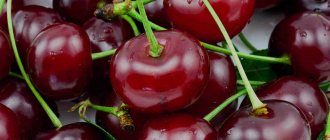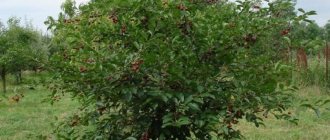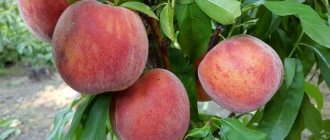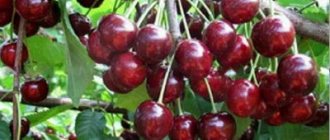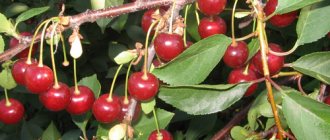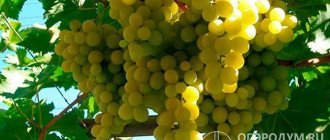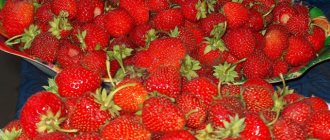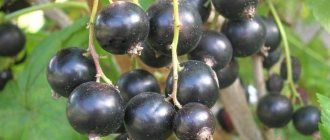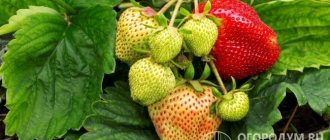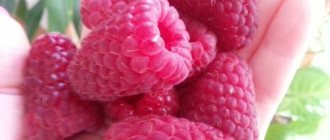The history of the creation of the variety
In the last quarter of the last century in the village. Michurinsky of the Bryansk region was the location of the All-Union Scientific Research Institute Lupin (later - a branch of the scientific center "Federal Scientific Center for Forage Production and Agroecology named after V.R. Williams), whose specialists specialized in creating varieties of forage crops, breeding new types of horticultural crops.
As a result, on the account of this institute there are more than 60 varieties of cherries, sweet cherries, currants, raspberries and apple trees, bred by the institute's specialists, including the Iput sweet cherry, which was bred by the specialists of M. V. Kanshina and A. A. Astakhov in the last quarter of the past. centuries. The bred variety was named in honor of the river of the same name that flows in the Bryansk region. In the 90s of the last century, the Iput cherry was submitted for adoption in the State Register of Russia, where it was included after tests in 1993.
Cherry Iput - photo
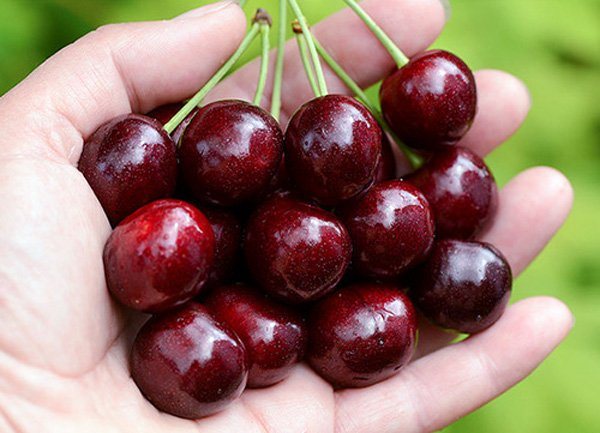
Cherry Iput: characteristics and description of the variety
Cherry Iput - a tree with a medium-sized central trunk and a wide crown, the height of an adult tree is about 3.5 m
, sometimes it can grow up to 4-4.5 m. The shape of the crown is broad-pyramidal. The color of the smooth bark of the trunk is brown with a reddish tint.
Shoots extend from the main trunk at an acute angle, well leafy, with reddish-brown bark. Foliage - medium length (up to 8 cm) and about 5 cm wide, ovoid, matte, slightly curved, has no pubescence.
Berries - large, weighing up to 9 g
, dark red, almost black. The skin is smooth, shiny, thin, almost invisible in food. The pulp is slightly firm, red, rather juicy, sweet, with a slight bitterness. The seeds in berries are small in size, in ripe fruits they are difficult to separate from the pulp.
On a note!
Tasting assessment of sweet cherry fruits Iput - 4 points out of 5 possible. The amount of sugars in ripe berries is 11.6, the amount of acids is small, not more than 0.7%.
The harvested crop tolerates transportation well. But if the fruits on the tree are cracked, then it will not tolerate transportation even for a short distance.
The collected fruits of this sweet cherry are universal, they are eaten fresh, and can also be preserved. From the cherry berries of the Iput variety, delicious jam, jam or compotes are obtained.
Cherry photo Iput


It should be noted that the ripe fruits of Iput cherries contain a large amount of vitamin C, which makes these fruits very useful for the human body.
The frost resistance of this fruit tree is quite high, because Cherry Iput can withstand cold up to -30 degrees Celsius
, and thus no damage to the shoots and trunk occurs. However, warming, which is then replaced by frost, is detrimental for this cherry. In this case, even a cold of -20 degrees after warming will destroy this fruit tree.
![Tinkoff (Debit Card) [CPS] RU](https://bgn.imadeself.com/wp-content/uploads/tinkoff-debetovaya-karta-cps-ru5.jpg)
![Tinkoff (Debit Card) [CPS] RU](https://bgn.imadeself.com/wp-content/uploads/tinkoff-debetovaya-karta-cps-ru5.jpg)
The drought tolerance of the Iput cherry variety is high
- even if the drought period is long, you should not water this tree more often than 1 aza every 6-8 days. Excess moisture is primarily destructive for ripening berries - they immediately begin to crack.
Diseases and pests
Cherry Iput is quite resistant to fungal diseases. But unfavorable conditions can provoke the development of infections.
Diseases characteristic of sweet cherry - table
| Diseases | Symptoms | Treatment methods | Prevention measures |
| Moniliosis | Buds, flowers, leaves, shoots and fruits are covered with gray spots, on which small pads with spores 1 mm in diameter are placed. | Treatment at the stage of swelling of the kidneys with 3% Bordeaux liquid, and then 2-3 weeks later with 1% solution. |
|
| Hole spot |
| Spraying the tree with Bordeaux liquid 1% concentration. | |
| Brown spot | Brown spots form on the leaves, after which they fall off prematurely. | In early spring, apply 1% Bordeaux liquid. | Destruction of leaves in autumn. |
| Fruit rot |
| Spraying when symptoms appear with a 1% solution of Bordeaux liquid. |
|
| Powdery mildew | Flowers, petioles and leaves are covered with a white bloom, which later turns yellow. | Three times treatment with a 2% solution of colloidal sulfur when signs of the disease appear with an interval of 15 days. | Pruning damaged branches. |
Typical ailments of the Iput variety in the photo
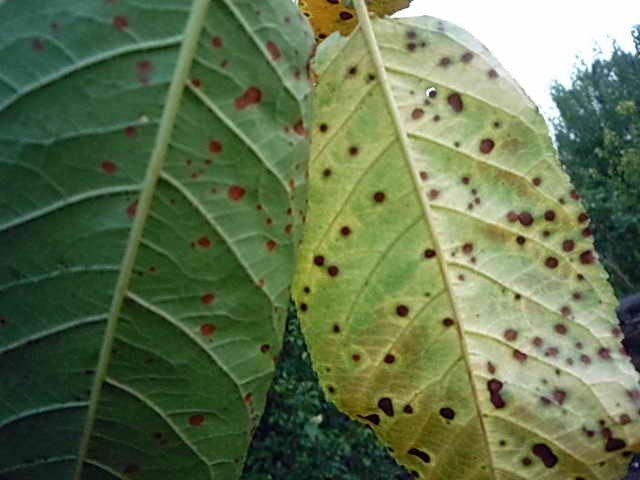

Hole spotting leads to the formation of ulcerative spots on the leaves
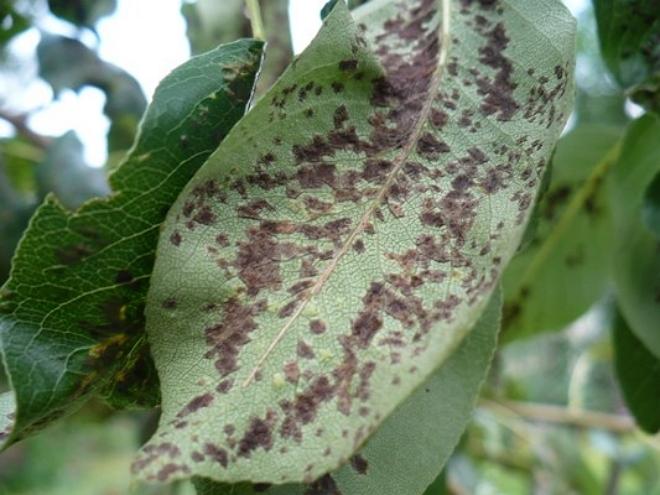

Brown spot appears on the leaves of stone fruit crops
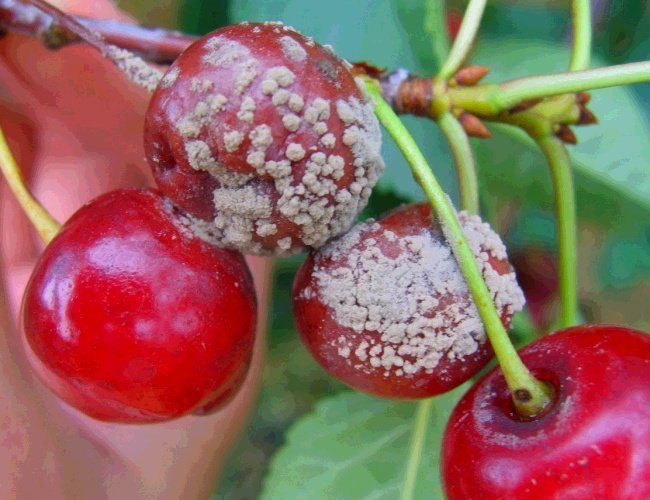

Moniliosis of sweet cherry harms the crop
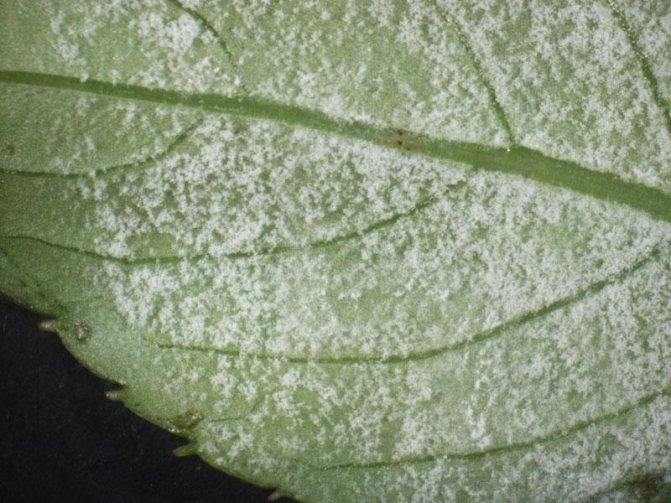

Powdery mildew is a fungal disease that damages leaves and young shoots
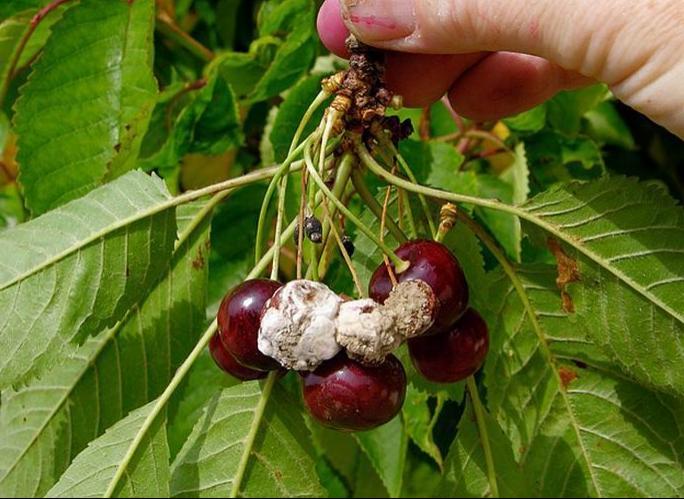

Fruit rot spreads quickly and destroys crops
Cultural pests - table
| Pests | Signs | Control methods | Preventive measures |
| Aphid | A sticky coating appears on the leaves, after which they roll up and dry out. | Treatment of wood with the appearance of pests with soapy water (300 g per 10 l of water) or with Inta-Vir (1 tablet per 10 l). | Removal of root growth. |
| Unpaired silkworm | Caterpillars eat leaves. | Spraying before bud break and during the formation of ovaries Inta-Vir. | Whitewashing in the fall and early spring of the trunk and skeletal branches. |
| Puffy leg |
| Application of Inta-Vira 10 days after the end of flowering. | Collecting fallen fruits and then burying them in the soil to a depth of 50 cm. |
| Cherry pipe wrench | The pest eats buds, buds, flowers, ovaries, also feeds on pulp, leaving passages in the berries. | After flowering and after 10 days, treatment with Aktara (1.4 g per 10 l). | Autumn digging of soil by 15 cm. |
| Leaf roll | Caterpillars eat buds, flowers, leaves, and also wrap the plates with cobwebs and twist them into lumps. | Before bud break, treatment with ZOV (300 ml per 10 l of water), at the stage of bud break, use of Confidor maxi (700 ml per 10 l). | Whitewashing wood processing. Destruction of fallen leaves. |
Insect pests characteristic of the variety - photo gallery
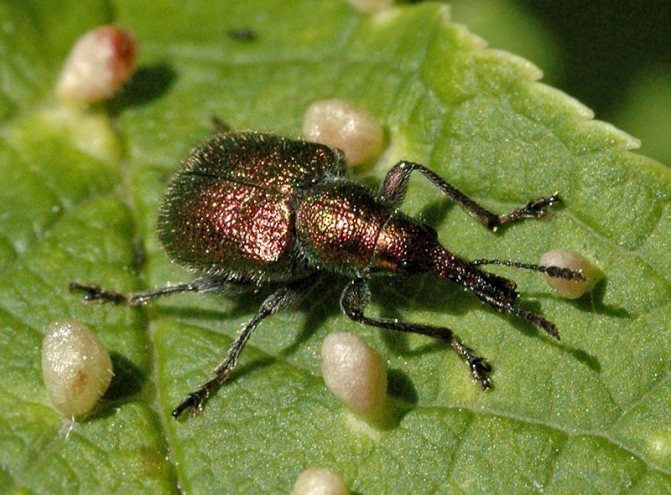

Cherry pipe-runner is a dangerous pest that affects the buds, shoots, and cherry ovaries
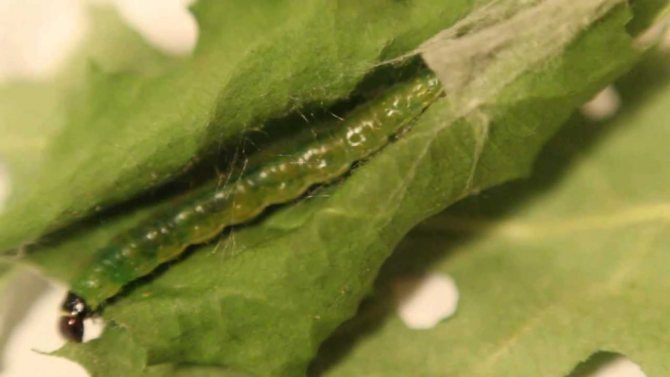

The leafworm depresses the crown, draining the tree
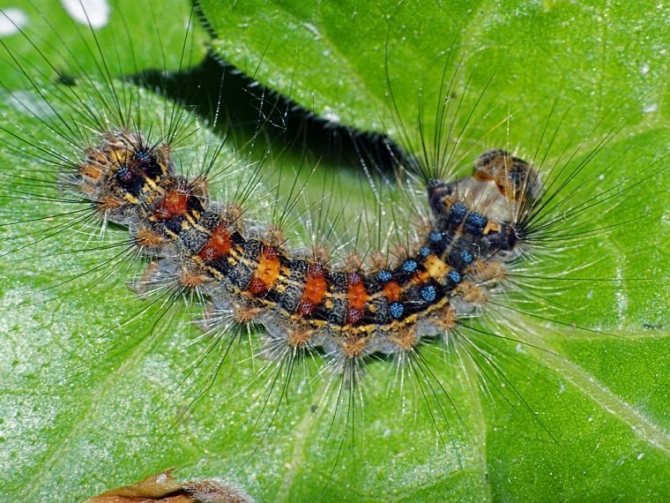

The unpaired silkworm quickly devours the leaves of the tree
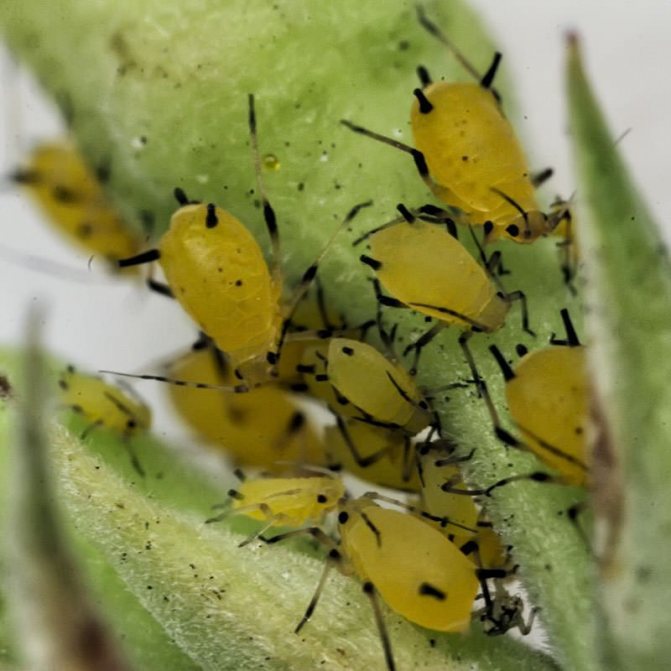

Aphids are a gluttonous parasite that eats stems and leaves of plants
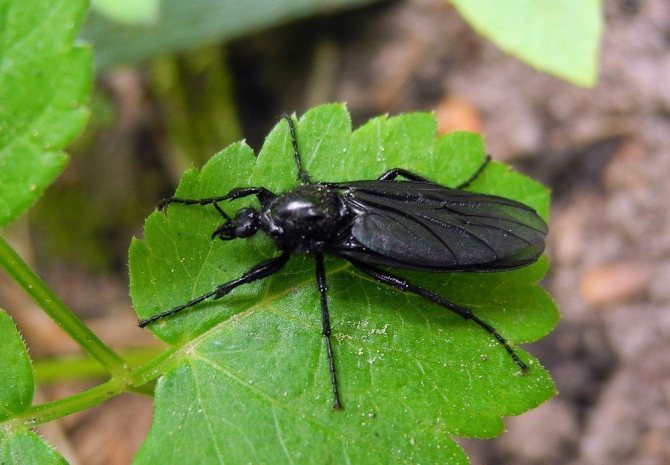

The thick-stemmed tree multiplies quickly and damages the tree, leading to the drying out of the berries.
The yield of the variety of cherries Iput
Fruiting of this variety begins 5 years after the trees are planted in a permanent place.
... The cherry begins to bloom in the second decade of May, the berries begin to ripen in the last days of June, therefore the Iput cherry variety is classified as an early cherry variety.
Cherry Iput - video
Fruiting is considered stable, and harvests are harvested annually. Each adult Iput cherry can be harvested up to 28-30 kg of ripe berries. But with good care and compliance with all agrotechnical measures, you can almost double the yield of the variety. When growing this sweet cherry on an industrial scale, up to 103-105 centners of ripe berries are harvested from one hectare.
Feedback
- Liza, 45 years old, Astrakhan “Cherry“ Iput ”was purchased six years ago, the tree is very strong and sturdy. It grows rapidly, already in the first year it was necessary to prune, otherwise it simply could not be said that this tree was. The first harvests were harvested in about the third year, before that the inflorescences fell and that's it. The berries are quite large, especially compared to the old tree. I will not say that it is too early a variety, rather a mid-season, although the nursery stated the opposite. In the fourth - fifth year, the harvest was already quite decent, but there is still not enough for conservation, you will have to annoy a couple more trees. We did not wait for "black" ripeness, the children practically ate the tree even when the fruits were crimson. The yield is excellent, at least not comparable to conventional varieties. Hopefully, after we grow more cherries, it will be possible to leave feedback on storage possibilities. ”
Pollinating trees for Iput cherries
Cherry Iput is a partially self-fertile variety, but in order to obtain high yields, it is necessary to plant other varieties of cherries with the same flowering time close to Iput.
The best "companions" or pollinating trees for Iput cherries can be:
- Tyutchevka;
- Veda;
- Bryanochka.
Experts recommend simultaneously planting next to Iput cherry seedlings and pollinating trees. As a result, these stone fruit trees will simultaneously reach fruiting and yield high yields due to cross-pollination.
Berry varieties!
Cherry FatezhCherry OvstuzhenkaCherry Leningradskaya black
Advantages of the variety
Experts refer to the main positive qualities of the Iput cherry variety:
- high frost resistance;
- fruiting - annual, stable and high;
- fruit ripening period - early;
- good resistance to major diseases and pests;
- due to the low height of the trees, harvesting is not difficult;
- ripe berries are versatile;
- good ripe fruit taste.
Of the disadvantages of the variety, gardeners should pay attention to the following:
- late onset of fruiting - 5 years must pass after the Iput cherry trees are planted before they begin to bear fruit;
- if an excess of water appears in the soil, then the fruits may crack;
- bones in ripe fruits separate too badly from the pulp.
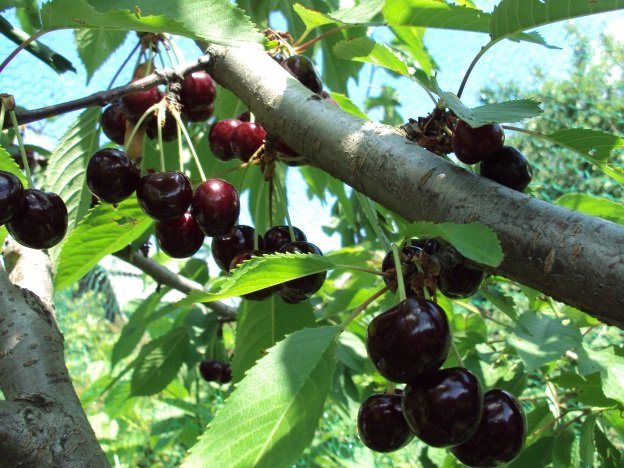

Fruit
The fruits of Iput are medium in size, weighing from four to nine grams. They are dark red in color when ripe - almost black. If you slightly overexpose cherries on a tree, the berries begin to crack from oversaturation with water.
The pulp is very juicy, medium density. The color is dark red, although lighter than the rind. The fruits are characterized as sweet and dessert with a subtle bitterness that adds piquancy. There are many useful substances in the composition.
In order to preserve the crop as long as possible, it is recommended to follow several rules:
- Collect cherries when they have not yet fully ripened and filled with moisture. Such berries crack even on a tree.
- Let the berries dry a little in the sun.
- Place in crates with holes, natural bags, or cardboard boxes. The main thing is not to store cherries in a plastic bag. The fruits do not breathe at all and quickly begin to deteriorate.
- Store crops in a dark, dry and cool place.A refrigerator is ideal, but few gardeners can afford to store tens of kilograms of cherries in the refrigerator. So put the berries in a cellar or other suitable place according to the description.
Planting cherries Iput - features and rules
When planting the Iput variety, other varieties of cherries should be planted nearby at the same time, so that by the time this cherry is fruiting, adult pollinating trees grow nearby.
In the southern regions of Russia and regions with a mild climate, this cherry variety can be planted in the spring and autumn months. Moreover, experts advise planting Iput cherries in the south in the fall, since when planting in spring during the summer, young trees can suffer from sunburn and lack of moisture.
Important!
And in the northern regions, it is impossible to plant Iput cherries in the fall - the tree will not have time to take root well before the onset of winter and will die during severe frosts.
Another prerequisite for planting seedlings is that they must be at rest - when planting in the spring before the buds swell, when planting in the fall - after the end of leaf fall.
Planting cherries Iput - video
In order for this variety to have consistently high fruiting in the future, the following conditions must be observed when planting Iput cherries:
- other fruit trees should not be planted between cherry seedlings - they will interfere with cross-pollination of cherries;
- the selected area should be sunny and protected from gusts of cold winds;
- planting cherries Iput should be in loamy or sandy loam soil with a neutral pH, loose and sufficiently fertile;
- groundwater should not approach the soil surface closer than 2 m;
- do not plant these fruit trees in lowlands or in places where moisture can stagnate.
You should not plant apple trees, pears and plums next to the Iput cherries.
... The best neighbors for this fruit tree will be other varieties of cherries, or cherries, it is also good to plant a vineyard or black elderberry nearby, which scares away aphids from neighboring trees.
The distance between adjacent planting pits is made about 3 m.The diameter of the planting pits should be about 1 m, and the depth - 80 cm.Then a nutrient substrate made up of garden soil, humus and superphosphate is laid out on the bottom of the pit.
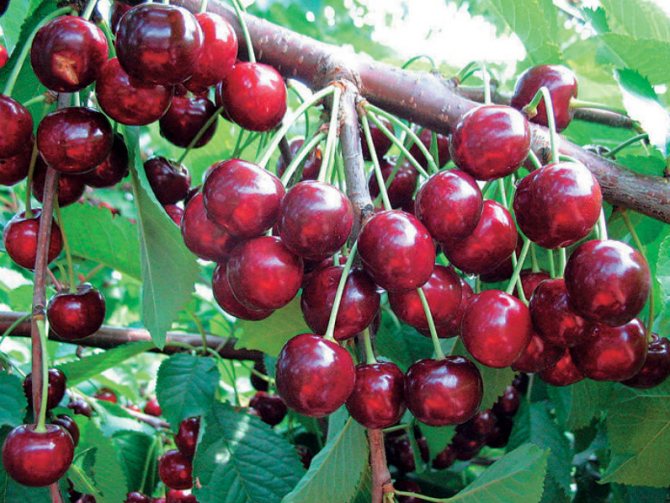

A stake is dug in near the center of the hole, to which the seedling will be tied after planting. The height of such a peg is not less than 0.9 m. In the center of the pit, a mound is made from the ground, on which the seedling is installed, and its roots are distributed along the slopes of the hill. Then the pit is covered with soil, tamping it. The tree is tied to a support and at least 35 liters of water is poured into the trunk circle. A layer of mulch with a thickness of 4-5 cm is laid in the near-trunk circle; straw or rotted sawdust can be used as a mulching material.
Care features
Proper care is the key to health and a good cherry harvest. By doing simple and regular steps, you can protect the tree from diseases and pests, help it survive the winter and increase the yield.
Pruning
Cherry Iput grows into a tall, large tree. Without proper crown formation, caring for it and collecting fruits will be very problematic. To solve these problems, the tree is carried out several types of pruning. Crown pruning is done in the first 4 years of tree growth, sanitary pruning is also necessary, and older trees sometimes need rejuvenating pruning. Since the crown of Iput is medium thickened, the problem of thinning is not too acute. Nevertheless, it is worth considering this point and thinking about lightening the crown with each pruning.
The scheme of crown-forming pruning for Iput cherries is better to choose a sparse-tiered one. It involves the formation of several main tiers of branches in a tree. For correct trimming, you should adhere to the following scheme:
- In the second year of tree growth, form the first tier of branches. The branches of the tier should be at approximately the same height (the distance between them should not exceed 10 cm).Pick 3-4 branches pointing in opposite directions. The competing branches of the longline should be removed, and the remaining branches should be cut by 20-25%. At the same time, the main shoot is shortened by 20-25 cm.
- In the third year, a second layer of 2-3 branches is formed on the tree. It should be 45-50 cm higher than the first tier. Competing branches of the tier are also removed, the branches of the second tier are shortened by 20%, and the branches of the first tier are cut so that they are 25 cm longer than the branches of the second tier. The main shoot is shortened by 15–20 cm. If there are branches between the tiers, they are shortened by 40%.
- In the fourth year of the tree's growth, the third and last tier of the crown is formed from 1-2 branches 50 cm above the second tier. Competing branches are also removed, the branches of the third tier are pruned by 20% and the main shoot is shortened at the same level. The branches of the second tier are cut so that they are 20-25 cm longer than the branches of the upper tier.
On this, the formation of the crown can be considered complete. Further, every year they make sure that the branches do not grow inside the tree and do not thicken the crown. Crown-forming and thinning pruning is carried out in the spring before bud break. In this case, the branches are cut to the outer bud, that is, a cut is made above the bud that is turned into the outer part of the crown, so that subsequent branches grow from the center of the tree outward.
Rejuvenating pruning is carried out every 10-15 years. At the same time, cherries are cut for three-year-old wood. If the crown is heavily thickened, you can also trim the main conductor by 40-60 cm. This will brighten the tree and rejuvenate it.
In the fall, 4-5 weeks before the onset of frost, the tree is sanitized. At the same time, all dried, diseased and deformed branches are removed. It is important to take into account the timing of the onset of frost so that the cherries have time to recover after pruning.
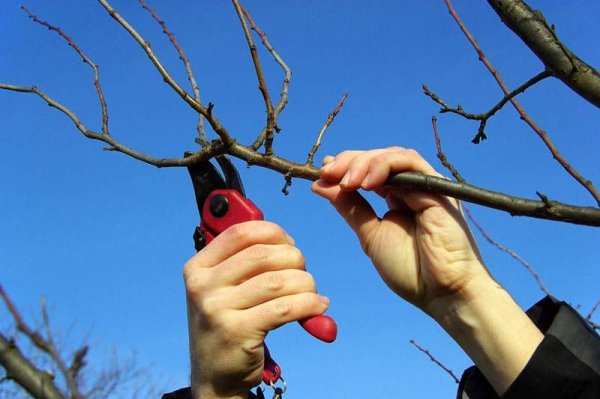

You need to prune the tree in spring and autumn.
All operations for cutting wood must be carried out with a disinfected and sharp instrument to avoid contamination of the tree, and after cutting with garden varnish or cover them with 3-4 layers of oil paint.
Watering
Watering is especially important for young trees. In the first year of growth, cherries are watered every week with 10-15 liters of water to help the plant take root. From the second to the fourth year of growth, cherries are watered every 2-3 weeks for 15-20 liters. An adult tree is watered 3-4 times a year: before flowering, immediately after flowering, after harvesting and in autumn, 30-40 liters, taking into account the weather conditions.
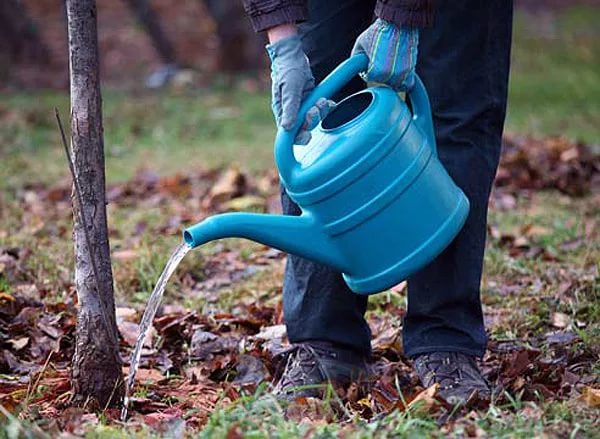

Young trees especially need regular watering.
In autumn, water-charging watering is carried out for cherries, spilling 50-60 liters of water for each square meter of the near-trunk circle. This procedure helps the tree to strengthen its root system and to survive the winter frosts more easily. It is best to irrigate by sprinkling or to form in the crown projection 3 irrigation grooves 7-9 cm deep each, radially located from the cherry tree trunk at 60, 100 cm and 140 cm, respectively. After watering, as well as after natural precipitation, the land under the tree must be loosened and mulched with straw or peat.
Crop protection
An important point in caring for a sweet cherry is to protect its harvest from birds. To do this, you can use special nets that are thrown over the tree and do not allow feathered pests. In addition, you can place sound scarers around the area or try to cope with birds using plastic bags and foil, attaching them to a tree.
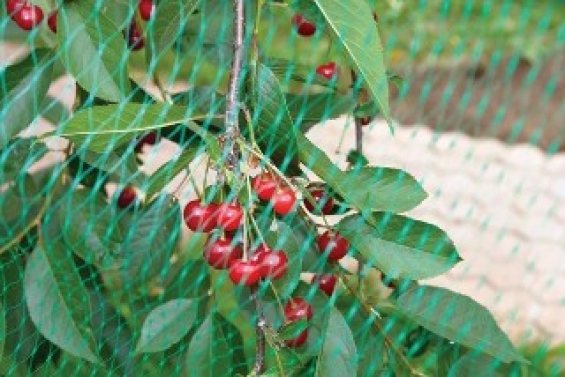

Cherry netting prevents birds from picking berries
Fertilizing a tree
For stable fruiting, the cherry tree needs regular fertilization. In the first year after planting, young cherries are not fertilized, since all the necessary substances were laid in the planting pit.Young trees from the second to the fifth year of growth are fertilized before flowering with ammonium nitrate for digging, 15 grams per square meter of area in the projection of the crown and 10 grams of urea per 20 liters of water in May after flowering. For mature trees, the dose of mineral fertilizers is doubled.
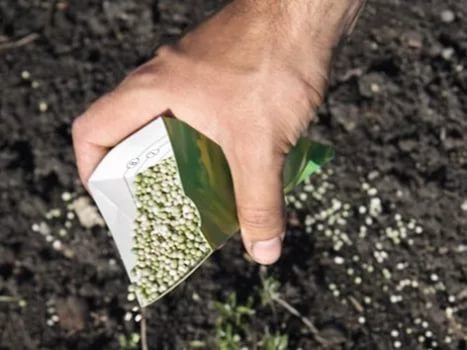

Mineral fertilizers allow cherries to give a bountiful harvest
Cherry also needs organic fertilizers. They are laid in the fall in the second and fourth year of tree growth, and then every 3 years. For fertilization in the crown projection, grooves are formed with a depth of 7–9 cm and a width of 15 cm, into which 15–20 kg of manure (two-year), 20–30 kg of compost or humus are placed, or the mother solution of chicken manure is poured. To prepare a mother liquor for a young tree, take 1 kg of dry droppings per 7 liters of water and infuse for 5 days, and then additionally dilute with 15 liters of water. For an adult tree, take 3 kg of droppings. The fertilizers placed in the grooves are sprinkled with earth from above. This method of application ensures a uniform supply of nutrients to the tree, and also protects the roots from burns.
Preparing for winter
Although Iput is a winter-hardy cherry variety, the tree needs preparation for the winter season. This preparation is especially important for young trees. For wintering cherries, the following operations are performed:
- The trunk circle is cleared of leaves, branches, weeds and grass, and then dug up to destroy pests hibernating in the ground.
- The trunk of the tree and 30% of the branches of the lower tier are whitewashed with a solution of 150 grams of copper sulfate, 0.5 kg of lime and 1 kg of powder clay, diluting the components in 15 liters of water for young trees and in 7 liters for adults. This difference in concentration is important to avoid burning the trunk of young trees. This operation protects the tree from diseases, pests and rodents, as well as avoids sunburn in the spring.
- The trunk circle is mulched with peat or sawdust 15–20 cm, and in spring, when a positive night temperature is established, the layer of mulch must be removed in order to avoid rotting roots.
- Trees can be additionally insulated with spruce branches.


Whitewashing is an important step in maintaining the health of cherries
A tree properly prepared for winter will be protected from frost and pests, so it will wake up faster in spring and give a better and more abundant harvest.
Top dressing of cherries Iput
Cherries should be fed several times per season:
- before flowering, ammonium nitrate is introduced into the trunk circles (for each square of the area - 1 tbsp. l.);
- during active flowering, urea is introduced, which is diluted in water - 40 g in 20 liters of water;
- during the period of ovary formation, a concentrate of chicken droppings, diluted in water in a ratio of 4 liters of concentrate to 20 liters of water, is introduced into the near-stem circles.
In the summer, you can feed cherries on the leaf using a solution of monophosphate or nitrophoska. In autumn, organic fertilizers are applied under each tree.
Important!
Only young Iput cherries up to 7 years of age should be fed annually. Then fertilizing is applied 1 time in 3 seasons.
Planting culture
- Sweet cherry loves loose, well-drained soil. The best option for planting this culture is a sunny, well-ventilated area with medium to light clay soil, the acidity of which is at least 5 pH.


A cherry seedling is rooted in a previously dug hole. Photo:
- The holes for planting seedlings are dug in the spring, two weeks before. Optimum hole sizes: width and length 100 cm, depth 80. The step between trees should be 3-4 m, row spacing -
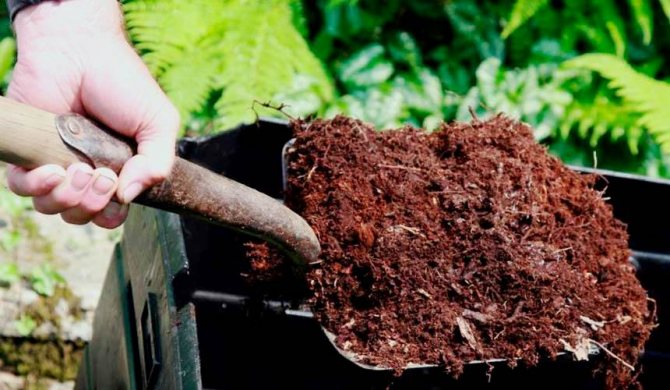

The soil before planting cherries is fertilized with humus. Photo:
- Half of the excavated soil is mixed with 20 kg of humus, 50 g of potassium sulfate and 200 g of furnace ash. The resulting fertilizer is scattered at the bottom of the hole. A thin layer of the remaining soil is laid on top of it.
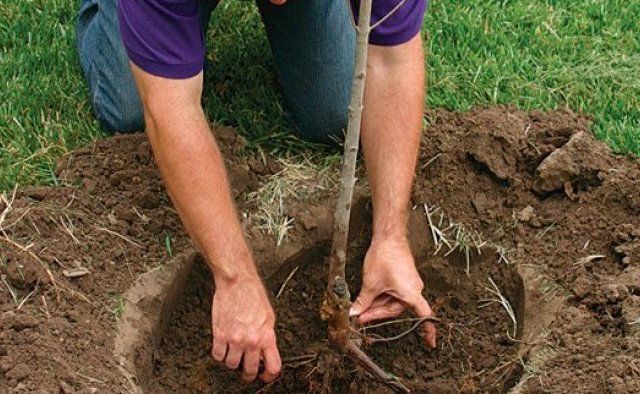

The roots of the seedling must be straightened when planting. Photo:
- The sprouts are set in holes and covered with earth, which is then compacted. Their root point of growth should be located 5-6 cm above the soil level.
- A peg is stuck next to the seedling and tied to it with a string.
- Further, the near-trunk circle is watered with 3-4 buckets of water.
Cherry Iput: pruning rules
The further abundant fruiting of the tree depends on the correct formation of the Iput cherry crown in the first years.
Therefore, it is recommended to carry out formative pruning of the Iput variety in the following way:
- the first time the Iput cherries are cut in the second season after planting. The first tier of the tree is formed at a distance of 50-60 cm from the ground, leaving no more than 4 skeletal branches. All other branches are cut in half or removed altogether;
- the next year, the second tier is formed, while at a distance of 50 cm from the first, all shoots are cut, leaving only two branches;
- next spring, 1 branch is left in the third tier, the main trunk is cut off;
- in subsequent years, all shoots are shortened by half.
How to properly prune cherries - video
Sanitary pruning is also carried out annually, removing all dried, damaged or diseased branches, as well as shoots growing incorrectly or thickening the crown.
Cherry Iput: reviews of gardeners who grow the variety
Larisa, 55 years old, Stavropol Territory: The Iput cherry variety has been growing on my site for 10 seasons. I want to note that ripe berries are liked by all my homemade ones - they are delicious, sweet. Cherry Iput does not require special care, the yield is good, I cover delicious fragrant compotes from the harvested crop.
Olga, 40 years old, Kursk: I bought a garden plot on which three adult Iput cherry trees were already growing. The trees have correctly formed crowns, according to their condition, it is clear that they were fertilized and watered on time. I want to say that this variety only pleases me with its yield and frost resistance.
Interesting!
Strawberry Festival
The cherry variety Iput has been popular among gardeners for several decades, as it is resistant to frost and disease, it is characterized by stable and abundant fruiting, an excellent taste of ripe berries, and their universal purpose.
Harvesting
The early maturity of this variety is at an average level. Fruits appear 4–5 years after planting. But the harvest ripens early - in mid-June. This, of course, is a conditional date, since everything depends on climatic conditions. Cherry Iput is famous for its regular harvests. With proper care, adult cherries will be generous with up to 50 kg of juicy berries from one tree.
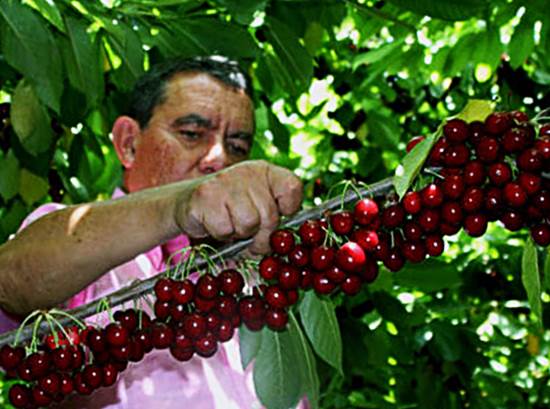

Cherry Iput is famous for its large harvests
You will have to collect cherries in several stages. Earlier, the fruits ripen, located on the most lighted branches. They begin to pick sweet cherries as soon as they have acquired the color corresponding to the variety - dark red, but at the same time the stalk should remain bright green. The fruits are removed very carefully, trying not to damage the bouquet twigs. If you have a small tree, then you can resort to the shearing method, using scissors with which to cut the berries without violating the integrity of the bouquet branches. Harvesting is done only in dry weather. Try to collect in boxes or shallow containers so that the delicate berry does not crinkle.
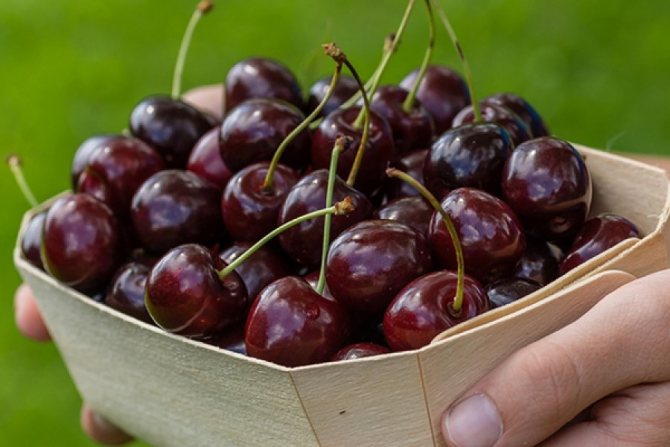

You need to pick cherries with a tail
Sweet cherries contain more than 80% water, so they cannot be stored for a long time. Whole berries can stay in the refrigerator for up to 7 days. At room temperature - only 2 days.
Sweet cherries are a very healthy berry, so have time to enjoy the fruits in their natural form. The Iput variety is also suitable for blanks. For the winter, you can use it to make confiture, jam, fruit puree, cherries in your own juice, boil compote and make a filling for baking.
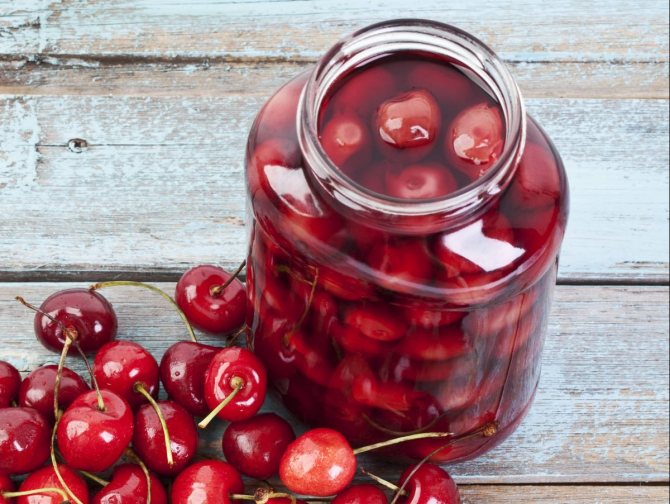

Cherries make a wonderful compote

